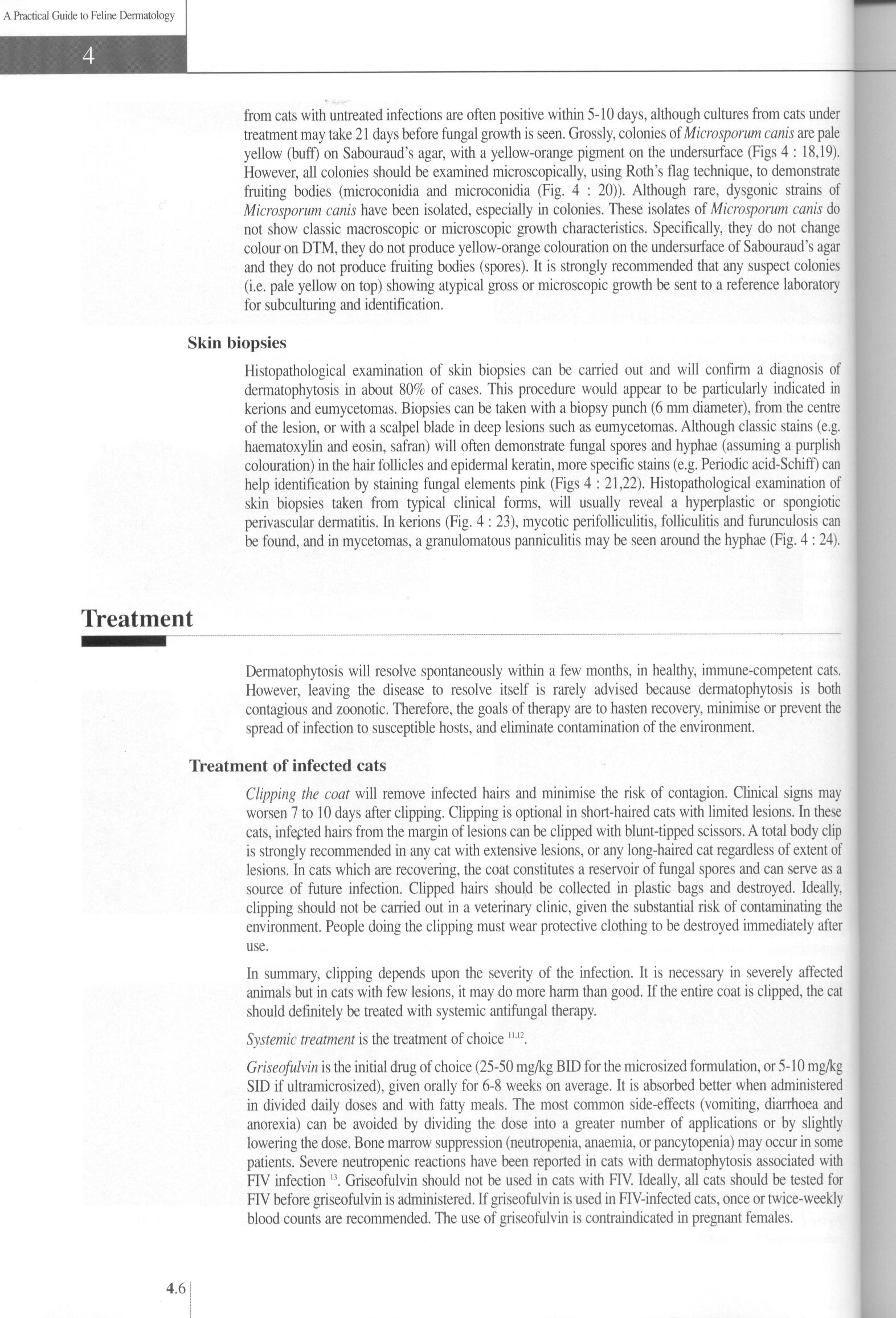46 (213)

4
A Practical Guide to Feline Dermatology
from cats with untreated infections are often positive within 5-10 days, although cultures from cats under treatment may take 21 days before fungal growth is seen. Grossly, colonies of Microsporum canis are pale yellow (bufl) on Sabouraud’s agar, with a yellow-orange pigment on the undersurface (Figs 4 : 18,19). However, all colonies should be examined microscopically, using Roth’s flag technique, to demonstrate fruiting bodies (microconidia and microconidia (Fig. 4 : 20)). Although rare, dysgonic strains of Microsporum canis have been isolated, especially in colonies. These isolates of Microsporum canis do not show classic macroscopic or microscopic growth characteristics. Specifically, they do not change colour on DTM, they do not produce yellow-orange colouration on the undersurface of Sabouraud’s agar and they do not produce fruiting bodies (spores). It is strongly recommended that any suspect colonies (i.e. pale yellow on top) showing atypical gross or microscopic growth be sent to a reference laboratory for subculturing and identification.
Skin biopsies
Histopathological examination of skin biopsies can be carried out and will confirm a diagnosis of dermatophytosis in about 80% of cases. This procedurę would appear to be particularly indicated in kerions and eumycetomas. Biopsies can be taken with a biopsy punch (6 mm diameter), from the centre of the lesion, or with a scalpel blade in deep lesions such as eumycetomas. Although classic stains (e.g. haematoxylin and eosin, safran) will often demonstrate fungal spores and hyphae (assuming a purplish colouration) in the hair follicles and epidermal keratin, morę specific stains (e.g. Periodic acid-Schiff) can help identification by staining fungal elements pink (Figs 4 : 21,22). Histopathological examination of skin biopsies taken from typical clinical forms, will usually reveal a hyperplastic or spongiotic perivascular dermatitis. In kerions (Fig. 4 : 23), mycotic perifolliculitis, folliculitis and furunculosis can be found, and in mycetomas, a granulomatous panniculitis may be seen around the hyphae (Fig. 4 : 24).
Treatment
Dermatophytosis will resolve spontaneously within a few months, in healthy, immune-competent cats. However, leaving the disease to resolve itself is rarely advised because dermatophytosis is both contagious and zoonotic. Therefore, the goals of therapy are to hasten recovery, minimise or prevent the spread of infection to susceptible hosts, and eliminate contamination of the environment.
Treatment of infected cats
Clipping the coat will remove infected hairs and minimise the risk of contagion. Clinical signs may worsen 7 to 10 days after clipping. Clipping is optional in short-haired cats with limited lesions. In these cats, infepted hairs from the margin of lesions can be clipped with blunt-tipped scissors. A total body clip is strongly recommended in any cat with extensive lesions, or any long-haired cat regardless of extent of lesions. In cats which are recovering, the coat constitutes a reservoir of fungal spores and can serve as a source of futurę infection. Clipped hairs should be collected in plastic bags and destroyed. Ideally, clipping should not be carried out in a veterinary clinic, given the substantial risk of contaminating the environment. People doing the clipping must wear protective clothing to be destroyed immediately after use.
In summary, clipping depends upon the severity of the infection. It is necessary in severely affected animals but in cats with few lesions, it may do morę harm than good. If the entire coat is clipped, the cat should definitely be treated with systemie antifungal therapy.
Systemie treatment is the treatment of choice IU2.
Griseofuhin is the initial drug of choice (25-50 mg/kg BID for the microsized formulation, or 5-10 mg/kg SID if ultramicrosized), given orally for 6-8 weeks on average. It is absorbed better when administered in divided daily doses and with fatty meals. The most common side-effects (vomiting, diarrhoea and anorexia) can be avoided by dividing the dose into a greater number of applications or by slightly lowering the dose. Bonę marrow suppression (neutropenia, anaemia, or pancytopenia) may occur in some patients. Severe neutropenic reactions have been reported in cats with dermatophytosis associated with FTV infection 13. Griseofulvin should not be used in cats with FIV. Ideally, all cats should be tested for FIV before griseofulvin is administered. If griseofulvin is used in FIV-infected cats, once or twice-weekly blood counts are recommended. The use of griseofulvin is contraindicated in pregnant females.
4.6
Wyszukiwarka
Podobne podstrony:
58 (148) 5 A Practical Guide to Feline Dermatology severity of the illness. High titres are seen wit
65 (127) 6 A Practical Guide to Feline Dermatology Other topical antimicrobial agents, such as chlor
67 (125) 6 A Practical Guide to Feline DermatologyNocardiosisAetiopathogenesis Nocardiosis is a very
69 (119) 6 A Practical Guide to Feline DermatologyDiagnosis The diagnosis is based on lesion distrib
710 (2) 7 A Practical Guide to Feline DermatologyHerpesvirus infections Dermatological manifestation
74 (105) 7 A Practical Guide to Feline Dermatology ulcerated. Lesion distribution is multicentric bu
27 A Practical Guide to Feline Dermatology Perianal glands 1.7 Permethrin 3.12, 3.13 Persian 1.6,2.2
27 A Practical Guide to Feline Dermatology Stemphyllium spp. 5.1,7.8 Stereotypie behaviour 17.1,
272 (16) 27 A Practical Guide to Feline Dermatology Alternaria spp. 5.1,7.8 Aluminium hyroxide 15.6&
274 (18) 27 A Practical Guide to Feline Dermatology Colitis 11.2 Collagen 1.2,2.6,12.1,
278 (17) 27 A Practical Guide to Feline Dermatology I J Histoplasmosis 5.8, 7.8, 25.2 Homer’s syndro
28 (374) 2 A Practical Guide to Feline Dermatology Configuration of lesions Determining the configur
313 (14) A Practical Guide to Feline Dermatology The second phase consists of long-term control of t
31 (328) 3 A Practical Guide to Feline Dermatology Sarcoptic mange Sarcoptes scabiei var canis (Tabl
82 (128) 8 A Practical Guide to Feline Dermatology considered important parasites. Cats in the Unite
42 (226) 4 A Practical Guide to Feline Dermatology Increased hydration and subsequent maceration of
44 (228) 4 A Practical Guide to Feline Dermatolog) The term “asymptomatically infected cat” refers
48 (209) 4 A Practical Guide to Feline Dermatology Table 4:1: Type of hair invasion, fruiting bodies
510 (5) A Practical Guide to Feline DermatologyCoccidioidomycosisAetiopathogenesis Coccidioidomycosi
więcej podobnych podstron